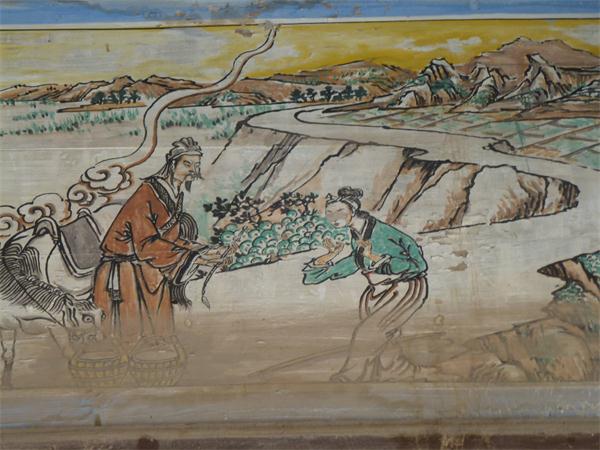Vanishing art and the rural villages of Shanxi

English tourists who travel to Shanxi want to see people perform their daily work, special Chinese craft and traditional dancing, alongside places steeped in exciting history. They want to hear traditional songs and stories. They want to experience an old China that existed before modern cities and industry. They want to see an ox pulling a plough and a farmer cutting maize. They want to experience an old village life long gone from Western countries. They are captivated by Chinese and Buddhist art and sculpture, ancient architecture, walls and old forts.
The province of Shanxi has all this, as well as the comfort and commercialism of its modernised cities. All of it is set in a rural scene, with a mountainous backdrop. Flat fields of golden maize and red flowered sorgrum surround small low villages of stone dwellings topped with corrugated tiles. Young trees and red leaved creeper form borders, filling every spare space. In ten years, Shanxi will be a province of deciduous and pine forests.
The villages are all that remains of a vanishing ancient China. Most young people have left for work in the cities, leaving an elderly population of farmers to grow and harvest the crops. They can be seen sitting together on stone steps talking about memories of the thriving village they grew up in. Their lives are brightened by visits from their family, and their homes by the bright red flowers they grow. They are sadly a dying community that would otherwise be a popular attraction for those who want a glimpse of the past. How can the songs, stories and crafts of these people be preserved?
A village is a community of people and attempts to artificially maintain its existence are doomed to fail. The Chinese government is conscious of problems caused by migration to the cities and is developing policies to make a return to rural life more attractive, but the building of modern apartment blocks is not the only answer. With the help of those left in the villages it may be possible to restore the structure of a village, yet sensitively update its facilities. As internet business is so widespread in China, it could be possible to attract these back to the countryside as domestic industries. I think about the Miao ethnic minority villages in Guizhou and the living museum of Morwellham in England. Both have become tourist attractions that show an old way of life, preserving skills and traditions. Villagers there become employed and the site is preserved.
The Victory Fort village near DaTong occupies the site of the old fort between inner and outer defensive walls. This was one of the gates in the wall between Inner Mongolia and China but has long since crumbled into brown earth banks. However, this village has major historical significance because of this. It is a fascinating place. At my visit here some colleagues had an opportunity to harvest maize while others stood on top of the remains of the fort to spy into Inner Mongolia. With careful restoration and a revival of its community and its rural industries, foreign tourists would appreciate such glimpses of a vanishing China. There are those who argue that doing this is false and pure commercialism, creating an artificial community less like a museum and more of a "freak" show. Yet how many ethnic communities would have vanished if not for such measures?
Art in Shanxi is also outstanding. Like the rural villages, it has been abandoned and neglected for a long time. Now Buddhist art, and countless pictures depicting Chinese stories that adorn the eaves of buildings, are being slowly restored. Unfortunately, Shanxi has so many examples of these that it will take many years to accomplish, and in the meantime, will they to be removed for safe-keeping, or left as they are?
Shanxi’s stories are depicted in paper cut pictures made in Guangling. Paper cutting is a common skill here, and a tourist can see such cuts all over China. It was with this in mind that I reluctantly ventured into the paper cutting factory.
"Such intricate designs are made by machines," I thought.
The museum here was on several floors and each floor showed more and more intricate cuts mounted on silk. Their delicate beauty and size astounded every visitor. And, there were no cutting machines! Skilled workers cut a block of 50 paper sheets at a time with sharp scalpels. Other skilled painters decorated the white paper seven sheets at a time, the paint soaking through and spreading to the vey edges of the cut pieces. More skilled workers finished the cuts and glued every tiny paper piece of every individual sheet onto silk backings. I cannot imagine how long it takes to make just one paper-cut picture. Some are sold for thousands of yuan. If you come here, bring a credit card! I think you will want to use it for that one special Shanxi souvenir.




















